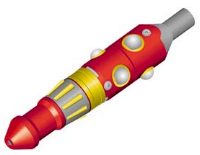01-02_technology-staff_2.htm (Feb-2001)
TECHNOLOGY AT WORKCompliant rotary tool improves sand screen expansionPaul Metcalfe, Director, Sand Control Systems and Expandable Products, Weatherford International, Inc. Successfully installing sand-exclusion devices in long, horizontal sections poses many problems – from both operational and production standpoints. Traditional methods of gravel packing often become less effective in horizontal wells for several reasons, including:
In such conditions, operators tend to apply the "stand alone" screen approach to avoid pitfalls that can be associated with gravel pack installations. However, such applications can also inhibit successful sand exclusion, since their lack of borehole support can lead to borehole collapse, sand movement in the annulus and screen plugging or failure. Expandable-screen limitations. To address the above problems with "conventional" screen installations, the Expandable Sand Screen (ESS) was developed. However, its deployment in long, horizontal sections presented its own difficulties. Expanding the screen is routinely achieved using a fixed-size cone and mandrel tool, which relies on application of set-down weight to expand the screen to a fixed diameter. In horizontal sections, it is often difficult, if not impossible, to achieve the set-down weight required to enable expansion. In addition, because of the extended time that the reservoir is often exposed to the drilling process, the resultant borehole face tends to be uneven. This results in lack of borehole support, because of the fixed diameter of the expansion process. Other difficulties that can be associated with fixed expansion tools are:
And the fixed diameter of the expansion tool results in a uniform screen expansion which, in turn, means that any parts of the borehole that are out of gauge will remain unsupported. Compliant tool solution. While successful ESS deployment has been performed in many areas, some of the limitations on its application envelope needed to be removed. An alternative expansion method required the following characteristics: 1) it must be capable of a variable diameter to enable the screen to be expanded to support as much of the borehole as possible; and 2) it must require considerably less set-down weight than standard tools, so that it can be effective in high-angle and horizontal wells.
To meet these criteria, Weatherford International, Inc. developed and patented the Compliant Rotary Expansion System (CRES), a hydro-mechanical tool that utilizes sets of circumferentially mounted rollers, each supported by pressure-activated pistons, see figure. Each set of rollers defines a cone when rotated and forces the expanding tubular out to contact the borehole. The tool is rotated using a standard mud motor. Circulating fluid used to drive the motor also operates the hydraulic pistons which, in turn, force the two sets of rollers to shape the expandable screen to match the borehole profile. This tool has the following features, which address problems inherent in fixed-diameter expansion tools:
Further, set-down weight requirements are typically only 10% of those required for conventional, fixed-size cone systems, thereby bringing most well geometries into the realm of the possible. Also, the time required to expand tubulars is typically reduced. North Sea application. The CRES was employed recently in a well in the North Sea, where a 4,000-ft length of ESS was to be installed in a horizontal section. The operator considered borehole support a key requirement for this application because the combination of high gas velocities and sand particle movement can lead to screen failure. In this application, 106 joints of 4-in. OD ESS, with an actual 4.4-in. OD, were run in the well and landed in the 6-in. dia. openhole horizontal section. They were then initially expanded using a 4.75-in., fixed-size cone, followed by a 4-in. CRES tool capable of expanding the ESS to an OD of up to 6.25 in.. The installation was completed successfully, even though it was conducted in severe weather conditions that resulted in ceasing operations twice during the expansion process due to high winds preventing pipe handling. All surface indications showed that the CRES tool was imparting work into the ESS and, when the tool was retrieved to surface, wear marks on the expansion rollers indicated the tool had, indeed, been functioning properly. It was possible to estimate from openhole caliper logs that about 90% of the borehole was contacted and supported by the screen. The well was completed and brought into production using rig-based testing equipment; and it achieved a cleanup rate some 30% higher than expected, with no sand production. The operator estimated that increased production resulting from the larger-than-normal bore through the ESS has added some $2.2 million to the well’s net present value. As a direct result of this successful well – the
world’s longest expandable sand screen installation – this operator plans further completions using
the system, to be expanded using the CRES, confirming its viability as an advanced alternative to fixed-sized,
cone-expansion tools. It is expected that CRES-type tools will find increasing use, not only in
expandable-sand-screen applications, but also in the in situ expansion of any solid tubular materials.
|
- Applying ultra-deep LWD resistivity technology successfully in a SAGD operation (May 2019)
- Adoption of wireless intelligent completions advances (May 2019)
- Majors double down as takeaway crunch eases (April 2019)
- What’s new in well logging and formation evaluation (April 2019)
- Qualification of a 20,000-psi subsea BOP: A collaborative approach (February 2019)
- ConocoPhillips’ Greg Leveille sees rapid trajectory of technical advancement continuing (February 2019)



